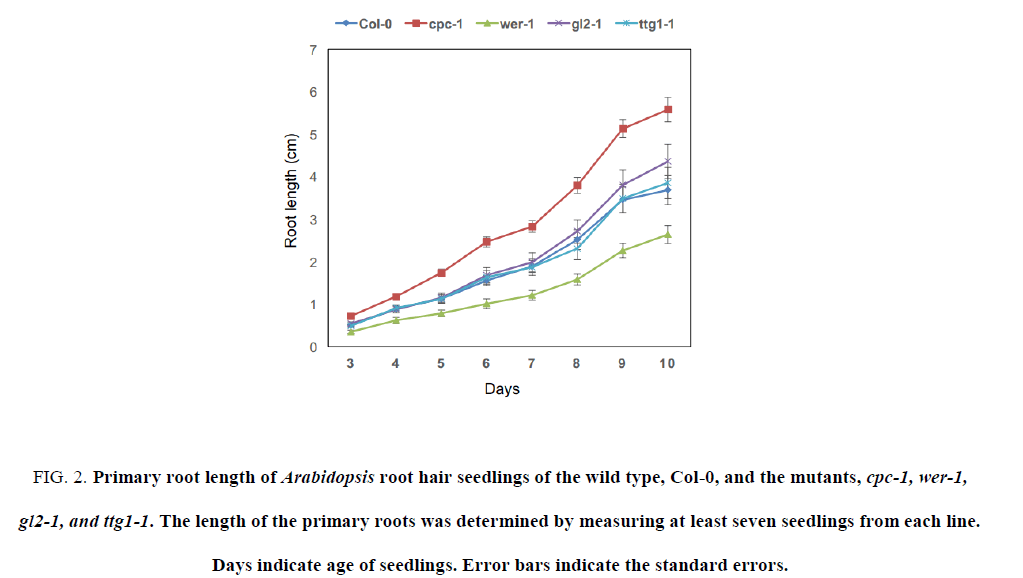Short communication
, Volume: 12( 3)Relationship between Root Hair Formation and Primary Root Length in Arabidopsis thaliana
- *Correspondence:
- Tominaga-Wada R, Graduate School of Biosphere Sciences, Hiroshima University, Higashi-Hiroshima 739-8528, Japan, Tel: 073276 61110; E-mail: rtomi@hiroshima-u.ac.jp
Received: September 12, 2017; Accepted: October 13, 2017; Published: October 16, 2017
Citation: Tominaga-Wada R. Relationship between Root Hair Formation and Primary Root Length in Arabidopsis thaliana. Res Rev Biosci. 2017;12(3):128
Abstract
Roots are important organs in all vascular plants. They anchor the plant, and absorb water and nutrients from the soil. During the growth of the plant, both primary root elongation and root hair formation occur. In the present study, we aimed to clarify the effects of root hair formation on primary root elongation. We measured primary root length in several mutant plants with different number of root hairs. The mutants with many root hairs showed similar or somewhat inhibited growth of the primary roots as compared with that of the wild-type plants. However, the mutant with few root hairs showed significantly enhanced primary root growth as compared with that in the wild type plants. Our results suggest that root hair formation might inhibit primary root growth. As the number of root hairs decreases, the growth of primary root might increase.
Rapid Communication
Plant roots facilitate the collection of water and nutrients that are essential for growth and survival. Differences in root architecture have been linked to the survival of plants under harsh environmental conditions. Root hairs are outgrowths on root epidermal cells. Owing to their large surface area, root hairs efficiently absorb water and nutrients needed for the plant. In Arabidopsis thaliana roots, epidermal cells differentiate into two types of cells, root hair cells and non-hair cells [1,2]. Root hair formation is controlled by root hair formation related transcription factors, including CAPRICE (CPC), WEREWOLF (WER), GLABRA2 (GL2), and TRANSPARENT TESTA GLABRA1 (TTG1), in Arabidopsis [3]. The cpc-1 mutant produces less root hairs than the wild-type plants [4]. However, the wer-1, gl2-1, and ttg1-1 mutants produce more root hairs than the wild-type plants do [5-7].
The A. thaliana cpc-1, wer-1, gl2-1, and ttg1-1 mutants were all described previously [4,6,8]. Plants were grown on agar plates as described previously [9].
In accordance with the previous results, cpc-1 showed significantly reduced number of root hairs as compared with that of wild-type plants Figure. 1 [4]. However, wer-1, gl2-1, and ttg1-1 showed approximately 1.5 times greater number of root hairs than that of wild type Figure. 1 [8].
Figure 1: Number of root hairs in seven-day-old Arabidopsis seedlings of the wild type, Col-0, and the mutants, cpc-1, wer-1, gl2-1, and ttg1-1. The number of root hairs per mm was determined by counting ten seedlings from each line. Error bars indicate standard errors.
Age of the seedlings had significant effects on the primary root length. All of the three-day-old mutant seedlings (cpc-1, wer-1, gl2-1, and ttg1-1) showed similar primary root lengths (approximately 0.5 cm) as that of the wild type Col-0 Figure. 2. However, the root length of ten-day-old seedlings varied from 2.6 cm to 5.6 cm Figure. 2. The cpc-1 mutant showed rapid growth characteristics throughout the measured period Figure. 2. The gl2-1 and ttg1-1 mutants showed similar growth profiles as that of the wild type, Col-0 Figure. 2. The wer-1 mutant showed the slowest growth curve over the entire measurement period Figure. 2. Our results suggest that the inhibition of root hair formation may contribute to promotion of the primary root growth.
Figure 2: Primary root length of Arabidopsis root hair seedlings of the wild type, Col-0, and the mutants, cpc-1, wer-1, gl2-1, and ttg1-1. The length of the primary roots was determined by measuring at least seven seedlings from each line. Days indicate age of seedlings. Error bars indicate the standard errors.
As we had expected, the presence of a smaller number of root hairs might be compensated by enhancement of primary root growth in the cpc-1 mutant. Intuitively, a large number of root hairs might trade off with primary root length in the wer-1 mutant. However, unexpectedly, the gl2-1 and ttg1-1 mutants showed similar primary root growth as that of wild type, Col-0. Many root hairs in the gl2-1 and ttg1-1 mutants might enhance the absorption of water and nutrients, thereby resulting in more primary root growth than their original potential. Further investigation with root hair or root growth mutants will help to elucidate the precise mechanisms controlling root phenotype.
Acknowledgement
We thank Y Nukumizu and M Iwata for the technical support, and T. Kurata, T. Ishida, and R. Sano for their useful suggestions. This work was supported by JSPS KAKENHI (Grant numbers 15K14656 and 16K07644).
References
- Dolan L, Janmaat K., Willemsen V, et al. Cellular organisation of the Arabidopsis thaliana root. Development.1993;119: 71-84.
- Dolan L, Duckett CM, Grierson C, et al. Clonal relationships and cell patterning in the root epidermis of Arabidopsis. Development. 1994;120: 2465-74.
- Tominaga-Wada R, Ishida T, Wada T. New insights into the mechanism of development of Arabidopsis root hairs and trichomes. Int Rev Cell Mol Biol. 2011;286: 67-106.
- Wada T, Tachibana T, Shimura Y, et al. Epidermal cell differentiation in Arabidopsis determined by a Myb homolog. CPC. Science. 1997;277:1113-16.
- Walker AR, Davison PA, Bolognesi-Winfield AC, et al. The TRANSPARENT TESTA GLABRA1 locus, which regulates trichome differentiation and anthocyanin biosynthesis in Arabidopsis, encodes a WD40 repeat protein. Plant Cell. 1999;11: 1337-50.
- Lee MM, Schiefelbein J. WEREWOLF, a MYB-related protein in Arabidopsis, is a position-dependent regulator of epidermal cell patterning. Cell. 1999;99:473-83.
- Di Cristina M, Sessa G, Dolan L, et al. The Arabidopsis Athb-10 (GLABRA2) is an HD-Zip protein required for regulation of root hair development. Plant J. 1996;10:393-402.
- Tominaga-Wada R, Iwata M, Sugiyama J, et al. The GLABRA2 homeodomain protein directly regulates CESA5 and XTH17 gene expression in Arabidopsis roots. Plant J.2009;60:564-74.
- Okada K, Shimura Y. Reversible root tip rotation in Arabidopsis seedlings induced by obstacle-touching stimulus. Science. 1990;250: 274-276.


